The Goddess of Love Gleams in the West with Maximum Mercury, the Waning Moon Leaves Lovers’ Treats, and Pretty Planets Parade before Dawn!
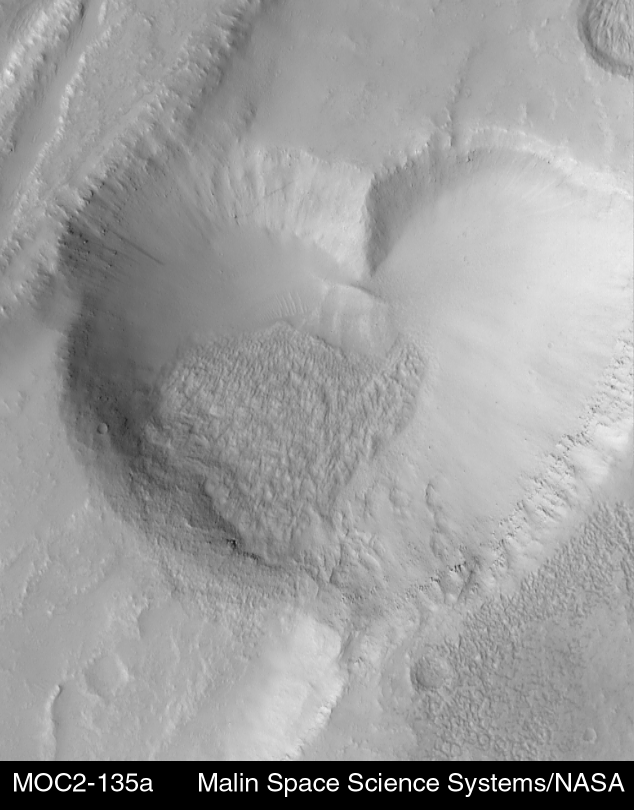
This heart-shaped feature on Mars was imaged by the Mars Orbiter Camera in 1999. It measures 2.3 km across at its widest, and is located on the eastern flank of the Alba Patera volcano in northern Tharsis. The sunlight is illuminating the scene from the left. The feature is a pit formed by collapse within a straight-walled trough or graben.
Hello, Night Sky Lovers!
Here are your Astronomy Skylights for the week of February 9th, 2020 by Chris Vaughan. Feel free to send me your comments, questions, and suggested topics. You can also follow me on Twitter as @astrogeoguy! Unless otherwise noted, all times are expressed in Eastern Time. To receive Skylights by email, please click this MailChimp link.
I can bring my Digital Starlab portable inflatable planetarium to your school or other daytime or evening event. Contact me through AstroGeo.ca, and we’ll tour the Universe together!
The moon will gradually depart from evening skies the world over this week as it transitions between full and late-rising last quarter, leaving us darker skies to enjoy the zodiacal light and some Valentine’s Day night treats. Venus, the Goddess of Love, will gleam in the western sky after sunset while Mercury proudly shows off below her – and nearby Neptune will kiss a golden star. Meanwhile, early risers can enjoy Mars moving towards Jupiter (and Saturn) in the pre-dawn east. Here are your Skylights!
Evening Zodiacal light
For about half an hour after dusk during the two-week period preceding the new moon on February 23, look west-southwest for a broad wedge of faint light rising from the horizon and centered on the ecliptic. That’s the zodiacal light – sunlight scattered from interplanetary particles of material that are sprinkled throughout the plane of the solar system. Try to observe the zodiacal light from a location without light pollution, and don’t confuse it with the brighter Milky Way, which extends upwards from the northwestern evening horizon at this time of year.
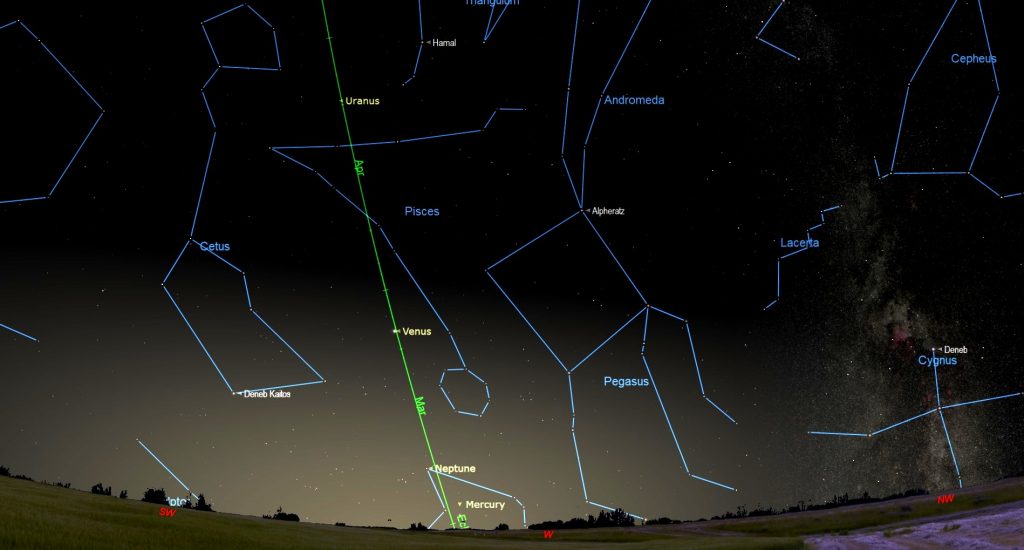
The Moon and Planets
Fresh from reaching its full phase this morning (Sunday), the very bright moon will dominate the evening and midnight sky all over the world during the first nights of this week. But as it commences the second half of its monthly orbit of Earth, the moon will wane in phase and rise later every night – leaving our evenings nice and dark on the coming weekend.
Tonight, the moon will rise shortly after sunset. It will appear full to your unaided eyes – but binoculars and telescopes will reveal that a sliver of its eastern edge (the right-hand side as viewed from the Northern Hemisphere) is darkened, and the terrain along that zone will sport shadows. An astronaut standing in that region would see the sun setting in the west.
I wrote about some of the interesting things to see on full moons here, and those items are still visible for a night or two after full. Meanwhile, Sunday night’s moon will be situated a few finger widths to the left (or 3° to the celestial north) of the bright, white star Regulus – the heart of Leo (the Lion). The moon will hop lower, to the eastern end of Leo, on Monday night.
From Tuesday evening through Friday morning, the moon will traverse the length of the large constellation of Virgo (the Maiden). Between 5:15 and 6 am EST on Thursday morning in the southwestern sky, the bright, waning gibbous moon will cross in front of (or occult) the dim, magnitude 10.2 main belt asteroid designated (3) Juno. The exact times vary by location. Observers in North America (except northeastern Canada), Central America, the Caribbean, and northern South America can see this event – but you’ll need a telescope to see the asteroid. Juno will disappear behind the bright, leading edge of the moon and re-appear from behind the dark edge – somewhat closer to the northern (top) part of the moon.
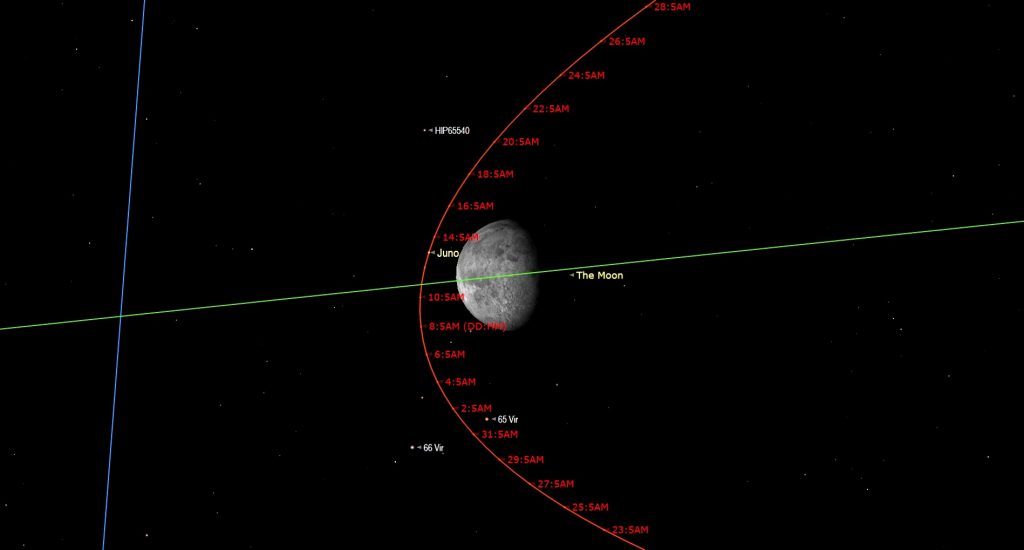
On Saturday at 5:17 pm EST, the moon will officially reach its last quarter phase. At that time, the moon will look half-illuminated, on the eastern side – towards the pre-dawn sun. At last quarter, the moon always rises around midnight and then it lingers in the southern daytime morning sky. That means that evening skies worldwide are moon-free for stargazing! To end the week, the waning moon will sit above the stars of Scorpius (the Scorpion) in the southeaster pre-dawn sky.
Mercury is putting on it best evening appearance during 2020 for equatorial and Northern Hemisphere observers around the world. On Monday after sunset, Mercury will reach peak visibility for this apparition, because it will be at its widest separation from the sun. That means that the sky will be darkening before Mercury sets at about 7:15 pm local time – making it even easier to pick out the speedy planet. You can look for the planet every night this week – sitting a generous palm’s width above the west-southwestern horizon after sunset. The optimal viewing time for Mercury will be between 6:15 pm and 6:45 pm in your local time zone. Mercury can be easily seen with unaided eyes in a cloud-free sky. If you use binoculars to hunt for Mercury, make sure that the sun has already completely sunk out of sight first.
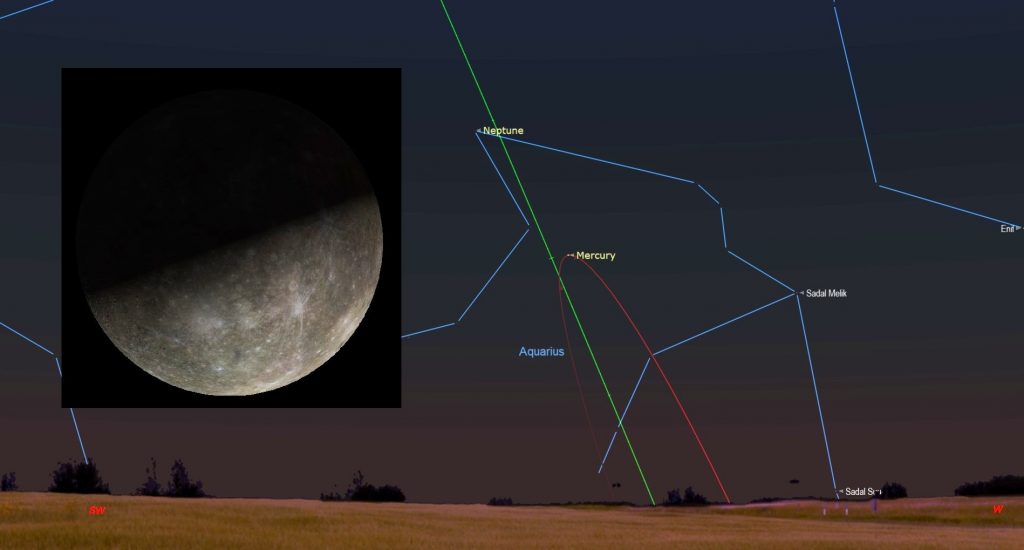
That incredibly bright “star” that you’ve been seeing in the southwestern sky every evening recently is Venus, the Goddess of Love for Valentine’s Day. She’ll gleam in the western evening sky until spring. This week, Venus will set in the west at about 9:25 pm local time. If you want to see Venus’ less-than-fully-illuminated disk in your telescope, try to view it as soon as you can find it, while Venus is higher in the sky. That way you’ll be viewing the planet through less of Earth’s distorting atmosphere.

Distant and dim Neptune is sitting between below Venus and above Mercury in the western evening sky – but Neptune is too dim to easily observe when it’s that low in the sky. If you want to give it a go, on the evenings surrounding Monday, February 10, Neptune will pass very close to the golden, medium-bright star designated Phi (φ) Aquarii – allowing Neptune to be easily located and viewed in backyard telescopes after dusk. Closest approach will occur on Monday night, when the planet and the star will be separated by only 2 arc-minutes and will easily appear together in the eyepiece of your telescope at high magnification. Remember that Neptune will be a definite blue colour while Phi Aquarii will be yellowish.
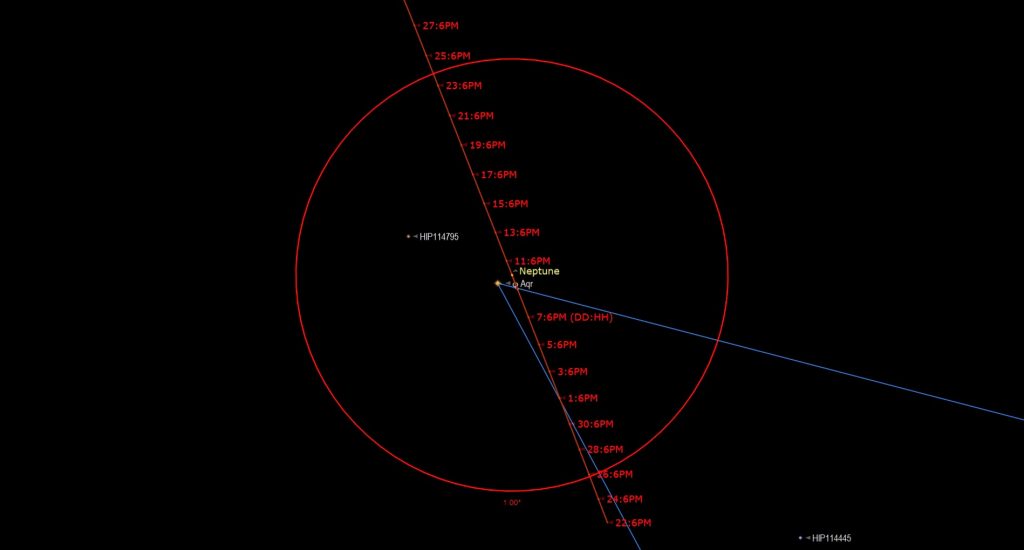
The only other observable evening planet nowadays is Uranus. The blue-green planet is observable for a few hours after dusk (it sets just before midnight local time). Uranus is located a generous palm’s width above (or 7° to the celestial east of) the modest stars that form the V-shaped constellation of Pisces (the Fishes) – although Uranus is actually located within the boundary of Aries (the Ram). The planet is positioned to the lower left (or to the celestial south of) that constellation’s two brightest stars, Sheratan (the lower, more westerly star) and Hamal (the higher, more easterly star). The planet is also a fist’s diameter to the lower right of the ring of stars that form the head of Cetus (the Sea-Monster).
Shining at magnitude 5.8, Uranus is bright enough to see under dark sky conditions with unaided eyes and with binoculars – or through small telescopes under less-dark conditions. To help you find it, I posted a detailed star chart here. If you view Uranus right after the sky darkens, it will be higher – and you’ll be looking through the least amount of Earth’s disturbing atmosphere.
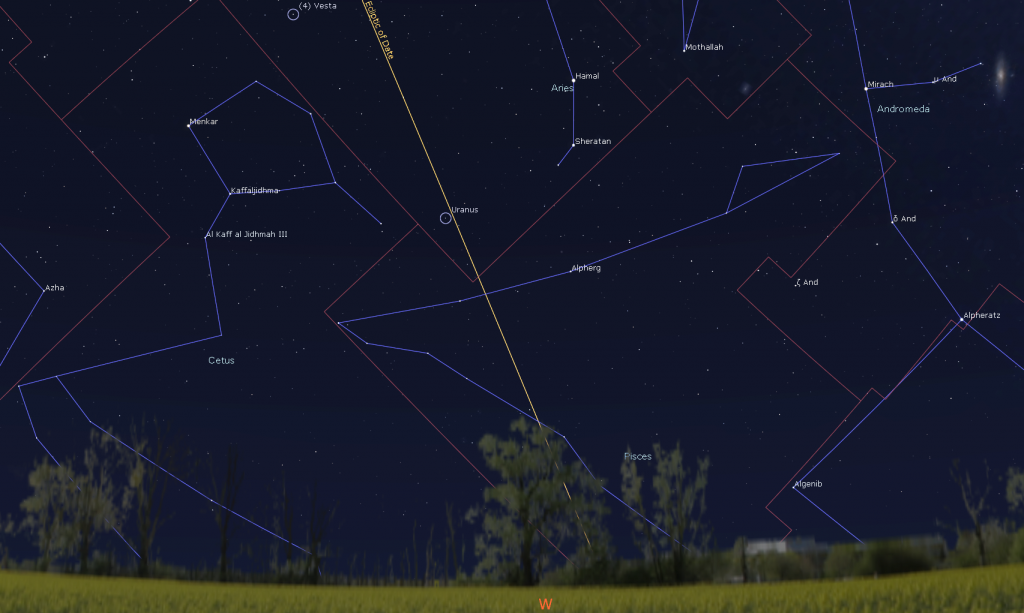
The rest of the planets are hanging out in the eastern pre-dawn sky. Mars is starting to increase in brightness as Earth moves towards it, with October being closest approach. The red planet will continue to shine in the southeastern pre-dawn sky this week, where it will remain for months to come. This week, Mars will rise at about 4:10 am local time and remain visible until dawn.
The relative positions and combined orbital motions of Earth and Mars are causing Mars to appear in roughly the same place in the sky at the same time every morning. However, the planet is actually moving rapidly eastward in front of the distant background stars because they rise four minutes earlier every morning – while Mars does not. This week, Mars will enter the stars of Sagittarius (the Archer) – and will soon pass close to many deep sky objects in that region of sky. Mars’ stellar rival, the bright, ruddy-tinted star Antares will be sitting 1.75 fist diameters to Mars’ upper right. That star marks the heart of Scorpius (the Scorpion).

Finally, if your southeastern horizon is low and free of obstacles, try and spot very bright Jupiter sitting two fist diameters to the lower left (or celestial east) of Mars. The giant planet will be visible from about 6 am local time until dawn. Saturn is there, too – but it’s too soon to look for it. Both Jupiter and Saturn will become easier to see every week.
I’ll post sky charts for all the observable planets here.
Valentine’s Night Treats
While there aren’t any official heart-shaped constellations in the heavens, there are some romantic couples in the stars that you can see with your unaided eyes on Valentine’s Day night. I’ve also got a few delightful Valentine’s-themed clusters and nebulas for your enjoyment – and even some heart-shaped craters on Mars! Below, I highlight a few of them. I’ll post sky charts and some photos here.
If you look about halfway up the west-northwestern sky during mid-evening you’ll see Princess Andromeda stretching upwards from the top corner of the big square of Pegasus. Andromeda’s hero, and eventual husband, Perseus is the constellation directly above her. It’s centre is marked by the bright star Mirfak. Between those lovers and a few fist diameters to their right (or 30° to the celestial northwest of them) are her parents’ constellations, w-shaped Queen Cassiopeia and King Cepheus. I told their story here.
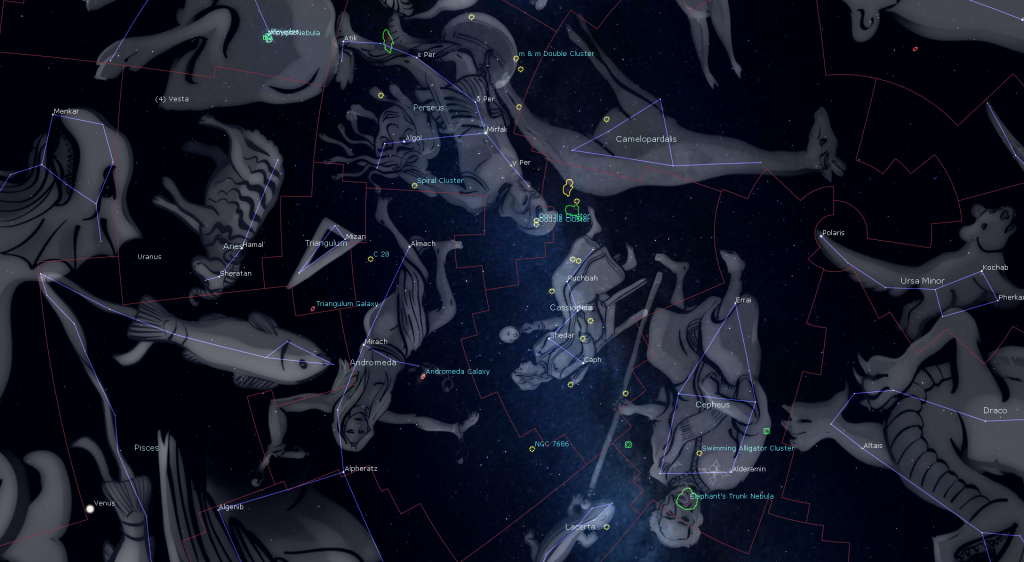
To celebrate fraternal love, we have the constellation of Gemini (the Twins) located in the evening sky to the upper left (or celestial northeast) of Orion. The two medium-bright stars Pollux (on the lower left) and Castor (on the upper right) mark the heads of the two brothers. Note that Pollux is a wee bit brighter and warmer in colour than Castor. Viewed through your telescope, Castor splits into a nice double star.
For a different type of devotion, we can highlight hunter Orion’s faithful companion Canis Major (the Big Dog). Easily found using its very bright star Sirius, aka the Dog Star, Canis Major forever and faithfully follows his master around the sky – although he might be more interested in chasing Lepus (the Hare), the constellation that sits to his west, below Orion.
If you aim your binoculars toward Orion’s eastern, left-hand belt star named Alnitak, and then look just a finger’s width below that star, you’ll find a pretty little group of stars arranged like Cupid’s Arrow! It’s dominated by a star named Sigma (σ) Orionis.
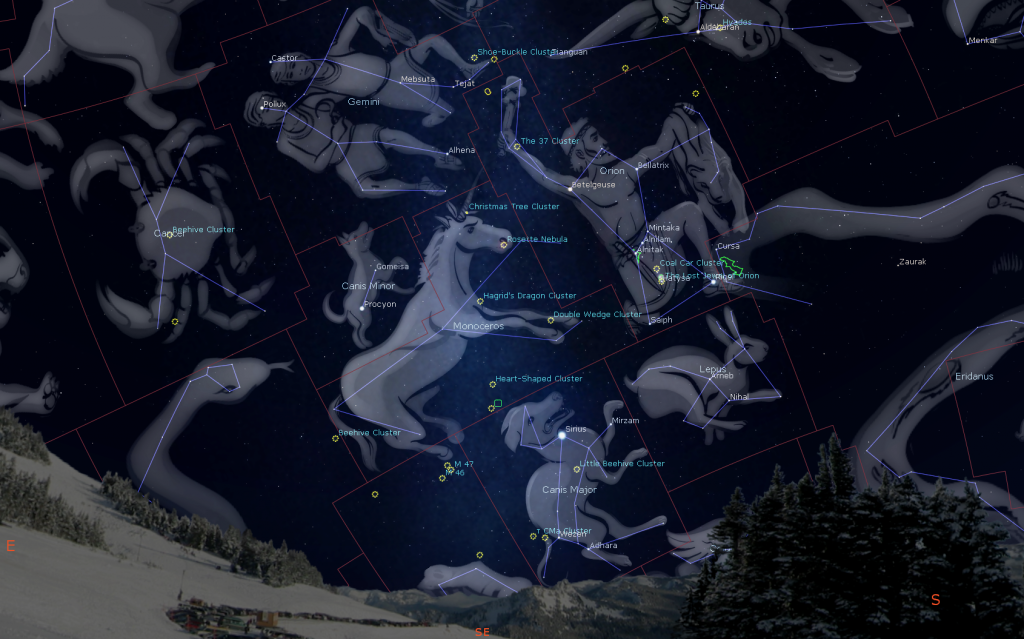
Beside Orion, on his eastern (left) side, and above Canis Major, is the constellation of Monoceros (the Unicorn). Its stars are mainly of medium and low brightness, but it sits squarely on the Milky Way and contains some delightful sights! The Rosette Nebula (also known as NGC 2244) is a beautiful rose-shaped cloud of reddish gas with a clump of bright little stars in its centre. It is located about a fist’s diameter to the left of Betelgeuse. The Rosette is visible in binoculars, but only long-exposure photos will reveals its colourful rose.
About a fist’s diameter above Sirius is Messier 50, also known as the Heart-Shaped Cluster and NGC 2323. This one is also visible in binoculars, although I don’t think that the heart shape is all that obvious. The cluster of mainly white stars features a bright, golden star at its lower edge.
Cassiopeia hosts the Heart Nebula, also known as the Valentine Nebula and IC 1805. It’s a truly beautiful object located 2,500 light-years away from us. This nebula and its companion the Soul Nebula (IC 1848) are located between Perseus and Cassiopeia – about three finger widths to the right of the Double Cluster. It’s too faint to see unless the sky is pitch black – but many lovely photographs of it have been published.
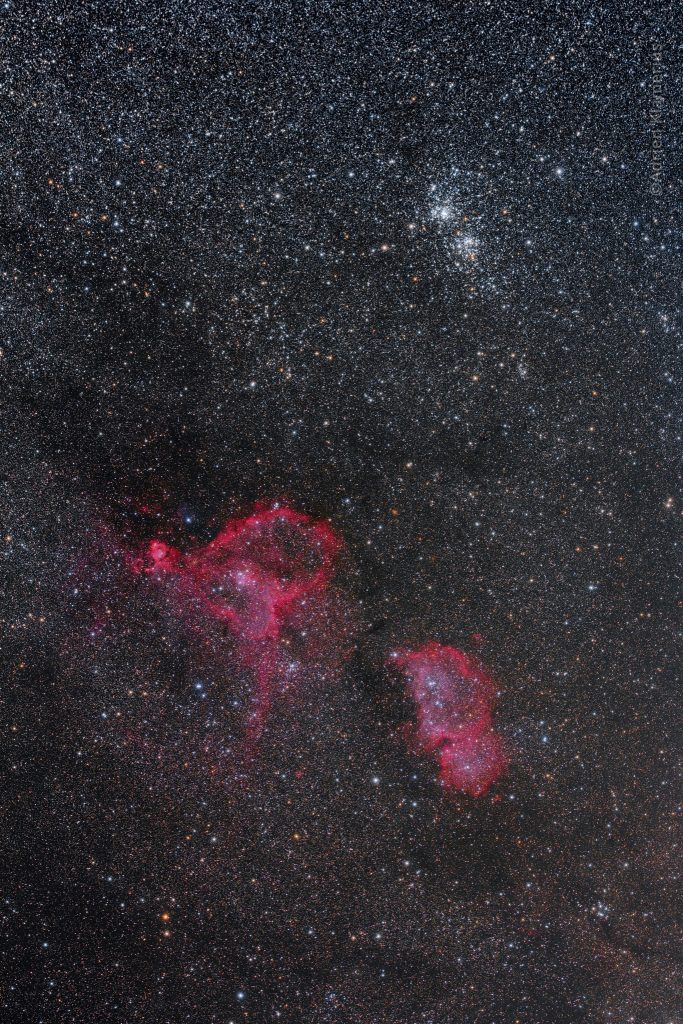
The high-resolution camera on the Mars Global Surveyor orbiter has captured the surface of Mars in great detail. Here and here are some Valentine’s hearts we’ve found on the Red Planet. Other love-themed solar system objects include the main belt asteroids (433) Eros and (477) Valentine.
Finally, to celebrate your favorite someone, why not find their Birthday Star. That’s a star that is located at the same distance from Earth (expressed in light-years) as that person’s age in years. In other words, the light you see now when you look at that star started its journey towards us when they were born. Visit this page and scroll down the list to find the age of any person and the birthday star for them. Then you can look for that star in the night sky – if it happens to be visible at this time of year from your location. It’s fun! And the stars for kids’ ages tend to be the closest and brightest stars in the night sky – and easy to see, even from the city.
Happy Valentine’s Day!
Super(bowl) Targets
If you missed last week’s suggestions for evening viewing, including a Superbowl connection, I posted it with sky maps here. Those items will look even better with the moon out of the way.
Binocular Comet Update
A relatively modest comet is traversing the northeastern evening sky this winter – and this week’s young, waxing moon will allow observers in the Northern Hemisphere to continue watching it. The comet is named C/2017 T2 (PanSTARRS), after the robotic telescope that discovered it and the date it did so. It is currently shining at about magnitude 9 – well within reach of medium or large binoculars and backyard telescopes. It is conveniently positioned in the sky for evening viewing. It’s very high in the northern sky after dusk – and then it drops lower in mid-evening as the Earth’s rotation carries the northwestern sky lower.

During the week, the comet will cross from Perseus (the Hero) into Cassiopeia (the Queen). If you face northwest, the comet will be positioned 1.5 fist diameters to the lower right of the very bright star Mirfak in Perseus, and a palm’s width above (or 5° to the celestial west) of the medium-bright star Ruchbah in Cassiopeia. Ruchbah marks the top of the shorter peak of Cassiopeia’s “M”-shape, which will sit sideways in mid-evening.
Comets move past the background stars faster than the planets do. Over the next seven nights Comet C/2017 T2 Panstarrs will shift by almost one finger’s width of sky, directly towards the star Segin, Cassiopeia’ highest star. I’ll post a sky chart here that shows the comet’s path during this week.
This week, the comet will also continue to sit a few finger widths to the lower right of the famous Double Cluster. That close-together pair of star clusters is visible to unaided eyes under dark skies and is very easy to see in binoculars from the city – making finding the comet very easy to find.
When viewed in binoculars and telescopes, Comet PanSTARRS will appear as a dim, fuzzy patch that might exhibit a faint greenish centre. Its modest tail should point roughly away from the Double Cluster. Let me know if you see the comet and if you see a tail! This comet is expected to brighten much more in the coming months. Stay tuned for updates!
Public Astro-Themed Events
Every Monday evening, York University’s Allan I. Carswell Observatory runs an online star party – broadcasting views from four telescopes/cameras, answering viewer questions, and taking requests! Details are here. On Wednesday nights they offer free public viewing through their rooftop telescopes, including their brand new 1-metre telescope! If it’s cloudy, the astronomers give tours and presentations. Registration and details are here.
On Tuesday, February 11 at 6:30 pm at Toronto Reference Library, University of Toronto Emeritus Professor of Astronomy John Percy will present a free public talk entitled The Birth, Life, and Bizarre Deaths of Stars. Details are here.
At 7:30 pm on Wednesday, February 12, the RASC Toronto Centre will hold their free monthly Speaker’s Night Meeting at the Ontario Science Centre, and the public are welcome. This month, the speaker will be Richard Bloch, PhD student, York University. His topic will be the nature of time, and relativity. Check here for details. Parking is free.
This winter, spend a Sunday afternoon in the other dome at the David Dunlap Observatory! On Sunday, February 9, from noon to 4 pm, join me in my Starlab Digital Planetarium for an interactive journey through the Universe at DDO. We’ll tour the night sky and see close-up views of galaxies, nebulas, and star clusters, view our Solar System’s planets and alien exo-planets, land on the moon, Mars – and the Sun, travel home to Earth from the edge of the Universe, hear indigenous starlore, and watch immersive fulldome movies! Ask me your burning questions, and see the answers in a planetarium setting – or sit back and soak it all in. Sessions run continuously between noon and 2 pm, and repeat from 2 to 4 pm. Ticket-holders may arrive any time during the program. The program is suitable for ages 3 and older. The Starlab planetarium is wheelchair accessible, but everyone else sits at floor level. For tickets, please use this link. Tickets for future dates will be available soon.
Keep looking up, and enjoy the sky when you do. I love questions and requests. Send me some!